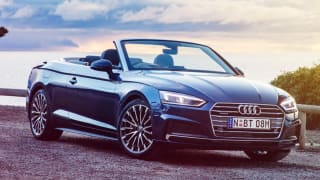
Audi A5 Cabriolet 2017 review
Audi's biggest, boldest convertible, the A5, will make up just 10 per cent of that badge's total sales, but the Germans don't do anything by halves, and they've thrown everything at the new Cabriolet.
Browse over 9,000 car reviews
By God, but hasn't Lexus come an awfully long way from what was undeniably a drab and dull past? The Japanese premium brand now routinely pumps out cars that are not just fun to drive, but are even *gasp* fun to look at, too.
And should you trace the genesis of all this new-found excitement, you'll find it was the Lexus RC that started it all. That car, unveiled at the Tokyo Auto Show in 2013, was an early sign that Lexus was going to start pushing the envelope with its passenger cars.
The two-door, four-seat RC has just been updated for 2018, with added technology, safety kit and even a particularly un-Lexus launch-control system in the most powerful models.
High time we took a closer look then, no?
| Lexus RC 2018: RC350 Luxury | |
|---|---|
| Safety rating | |
| Engine Type | 3.5L |
| Fuel Type | Premium Unleaded Petrol |
| Fuel Efficiency | 9.4L/100km |
| Seating | 4 seats |
| Price from | $44,660 |
As it is with most of the Lexus range, the RC model comparison is pretty straightforward. You need to pick your engine (300 or 350) and then choose your trim level (how much you want to pay), be it Luxury, F Sport or Sports Luxury. Only the RC F model line differs, because here you can choose from the base RC F trim, or the more expensive RC F Carbon.
Engine and kit aside, the RC family is the same basic set-up; four seats, two doors and coupe styling. The rest, then, depends on your intended price range.
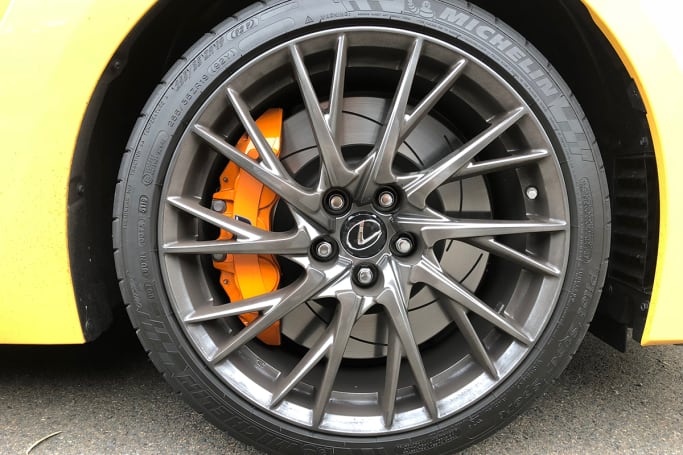
Entry-level Luxury cars - $65,400 for the 300, $68,400 for the 350 - arrive with 18-inch alloy wheels, LED headlights and fog lights, leather trim, standard navigation, heated and ventilated front seats, dual-zone climate and keyless entry with push-button start.
Step up to the F Sport Trim - $74,700 for the 300, $77,700 for the 350 - and you'll get bigger 19-inch alloys, a better Mark Levinson stereo and rain-sensing wipers.
Finally, the Sports Luxury models - $84,900 for the 300, $87,900 for the 350 - get better seats, some fancier cabin furniture and a moonroof. All the RC models get a new 10.3-inch screen (but no Apple Car Play/Android Auto).
Step up to the the V8-powered RC F models - $138,100 for the base model, $152,300 for the RC F Carbon - and you'll add adaptive variable suspension and an improved safety package that we'll come back to under the Safety sub-heading. The Carbon variant - predictably - gets a carbon-fibre roof panel, active rear wing and some carbon-fibre interior trim elements.
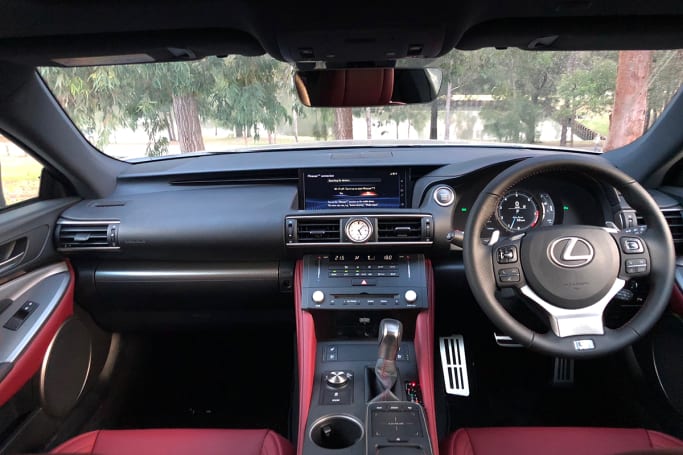
On the colour palette, the regular RC range is available in 'Sonic Quartz' (white), 'Mercury Grey', 'Premium Silver', 'Sonic Titanium' (another silver), 'Onyx' (black), 'Graphite Black' and 'Infrared' (red). The performance-flavoured RC F cars nab some extra choices, including 'Cobalt Mica' (blue), 'Lava Mica' (orange) and the brand's new hero colour, 'Zinnia Yellow'.
A moonroof (or sunroof) is standard fit on the RC F models, as well as the Sports Luxury trim, while it's a cost option on the cheaper cars. Speaking of which, you'll find all sorts of goodies in the accessories catalogue, including unique floor mats.
Each price listed is the RRP, of course, so you'll be paying more in on-road expenses. But you knew that already, right?

Yes, yes - eye of the beholder and all that business. But for mine, the RC looks terrific. We cycled through two models, the RC350 and the performance-focused F Sport, and both cut a fine and athletic figure on the road.
Front on, the pincered grille dominates the view, sweeping back into bonnet, and stretching to the lowest corners of the front end, while a flared-lip body kit runs the length of the body. Special mention also goes to the cat-claw swipes that live behind the rear wheels.
The regular RC models make do with twin exhaust tips, while the F Sport range scores quad pipes, separated by a slinky rear diffuser, and the rear spoiler is an integrated lip that forms part of the boot. Cooler still, the Carbon Edition adds lightweight elements, like a carbon-fibre roof panel and an active rear wing - with about 6.6kg shaved off the kerb weight.
Climb inside, and you'll find a quality - if slightly dated interior - with soft leather seats, carbon-effect trim elements and a new, 10.3-inch screen in the centre of the dash.
As you can see from our interior photos, though, some elements do now feel a little behind the times. The door panels feel harder than I'd like, almost as if a thin-piece of leather has been stretched over hard plastic, and the control unit in the middle of the cabin is awash with hard black plastic, and the knobs mounted on it feel a touch cheap and non-premium, too.
Now look, if you see a future filled with trips to Bunnings or ferrying the troops to soccer training, the RC is not for you. It's a two-door, four-seat coupe - and those two rear seats couldn't be less helpful for adult-sized humans if they'd been painted on.
Its dimensions measure 4695mm in length, 1840mm in width and 1395mm in height, but most of that space is focused on the front-seat riders, where your surrounds feel sporty-snug, but not claustrophobic.
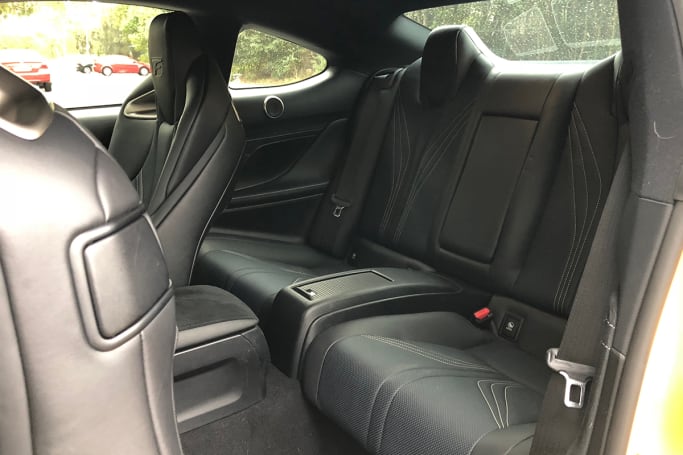
Up front, that cursed mousepad control system is still in full flight, but the screen it controls is now bigger. There are two cupholders to be shared between front-seat folks, as well as the usual compliment of USB and 'aux' connections. And even a CD player, for that matter.
Climb into the back, which is no easy task in and of itself, and you'll find the space cramped for anyone but kids. But while it's tiny, it's clever. Deep cut-outs in the rear of the front seats mean more room for your legs. Headroom, however, is a problem, and my (I'm 176cm) head was touching the roof.
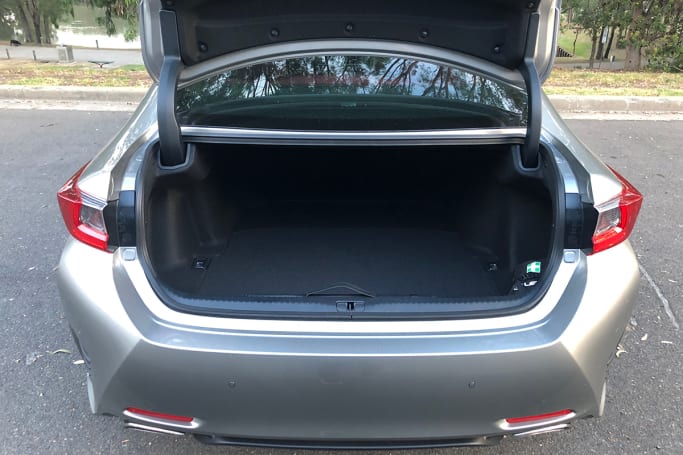
There are two cupholders, at least, but - surprisingly - little in the way of entertainment connections. You will find an ISOFIX attachment point in both of the rear seats.
The boot opens to reveal a fixed 423 litres of space, which is handy enough for weekends away. Predictably, though, extra practical accessories are fairly limited - you can forget optional roof racks.
The more you spend, the more you get. Spring for the 300, and you'll find a 2.0-litre turbo engine nestled under the bonnet, good for 180kW at 5800rpm and 350Nm at 1650rpm. It pairs with an eight-speed automatic, and shuffles power to the rear wheels.
Step up to the 350-badged cars and your engine specs improve accordingly. You'll now find a 3.5-litre V6 motor providing the horsepower, good for 232kW at 6400rpm and 380Nm at 4800rpm. The gearbox (eight-speed auto) remains the same, and the power is still sent to the rear axle.

The pick of the power bunch, though, is the 5.0-litre V8 engine nestled in the RC F cars. It'll fire 351kW at 7100rpm and 530Nm at 4800rpm toward the rear wheels - more than enough to shift the 1820kg (tare) weight. It's paired with an eight-speed automatic, or what the Lexus spec sheet refers to as a "Sports Automatic".
There is no AWD or manual transmission option anywhere in the range, and for specific oil type etc, consult your owner's manual.

Let's start from the top, shall we? There is a price to pay for power, and the V8-powered Lexus arrives with its claimed 10.9L/100km on the combined cycle. That's quite a lot, and it's a number that will surely only worsen if you drive the RC F the way that you really should drive it.
Things improve with the 3.5-litre capacity engine, recording 9.1L/100km on the same cycle, while the 2.0-litre engine will return 7.3L/100km.
There is no diesel engine anywhere in the range, and the fuel-tank capacity across the board is 66 litres, with 95RON fuel required.
Having now spent a fair chunk of time behind the wheel of the V6 and V8-powered cars, we're ready to make a pretty bold claim: the six-cylinder engine is - and there's no other way to put it - simply more fun.
Shocking, I know, but there it is. There's effortless power on offer in the RC F models, of course, but it's the way that power is delivered that makes it feel like more of a loping grand tourer than a fire-breathing performance coupe.
For one, both the power and exhaust notes arrive in stages. So if you're gentle with the throttle - like you almost always are in the CBD or suburbs - it wafts around in near silence, the engine feeling anaesthetised, and like it's only using a tiny proportion of its available oomph.
The V6 engine just feels sportier. It's still not super emotional, but I think it reacts to inputs quicker.
Leave your foot buried, however, and the character transforms, the exhaust booming into life and that big V8 finally unlocking its prodigious power. With the adaptive dampers (no air suspension) set to the sportiest setting, it sits flat in corners, with nary a roll through the body. And while there isn't an intimate connection with the road below, nor masses of feedback through the steering, it does acquit itself well on the bends.
But... the V6 engine just feels sportier. It's still not super emotional, but I think it reacts to inputs quicker, and comes alive a little lower in the rev range than the big V8. It doesn't really matter if you're in Normal, Sport or Sport+, it just feels more vibrant. Hell, you can even get the traction light flashing if you're particularly silly with the accelerator.
And as such, it's our pick of the bunch. Sure, it can't match the outright performance of the V8, nor the speed of its 0-100km/h acceleration time, but it puts a bigger smile on your face in normal, day-to-day driving. And let's face it, that'll be 90 per cent of the time you spend behind the wheel.
Basic Warranty
4 years / 100,000 km warranty
ANCAP Safety Rating

Standard safety across the RC includes dual front and front-side airbags, as well as front airbags for the second row. You'll also find a knee airbag for both driver and front-seat passenger. Forward-collision warning with AEB (and pedestrian protection) is standard fit, too, and so are front and rear parking sensors and a parking camera.
F Sport and Sports Luxury-badged cars add blind-spot monitoring and rear cross-traffic alert, along with lane-departure warning and lane-keep assist. The RC F and RC F Carbon both get radar cruise control and an active lane-departure system included in the standard offering.
The Lexus RC range is yet to be crash-tested by ANCAP, and so is yet to receive an Australian safety rating.
The RC range is covered by a four-year/100,000km warranty, with service intervals pegged at 12 months/15000km. There is no capped-price servicing program on offer, but Lexus will guarantee you a loan car every time your vehicle is in the shop, and will even come to your house or workplace to collect - and drop-off - your car.
For any owner-reported reliability problems, keep and eye on our Lexus ownership page.
Still a rock-solid option in the (admittedly not massive) premium-coupe space, the Lexus RC looks and feels like a quality product. The 2018 update has addressed any safety shortcomings, even if the interior technology still feels a touch behind the times.
But an out-and-out performance car this ain't. Even in cars fitted with the big V8 engine, the RC behaves more like an effortless grand tourer than it does a performance coupe. But if we're being really honest with each other, that only serves to make it much easier to live with.
| Vehicle | Specs | Price* | |
|---|---|---|---|
| RC350 Luxury | 3.5L, PULP, 8 SP AUTO | $44,660 – 51,920 | 2018 Lexus RC 2018 RC350 Luxury Pricing and Specs |
| RC F Carbon | 5.0L, PULP, 8 SP AUTO | $84,590 – 97,240 | 2018 Lexus RC 2018 RC F Carbon Pricing and Specs |
| RC200T Sports Luxury | 2.0L, PULP, 8 SP AUTO | $56,100 – 64,460 | 2018 Lexus RC 2018 RC200T Sports Luxury Pricing and Specs |
| RC350 F Sport | 3.5L, PULP, 8 SP AUTO | $49,610 – 56,980 | 2018 Lexus RC 2018 RC350 F Sport Pricing and Specs |
| Price and features | 8 |
|---|---|
| Design | 8 |
| Practicality | 7 |
| Under the bonnet | 8 |
| Efficiency | 8 |
| Driving | 8 |
| Safety | 8 |
| Ownership | 8 |
$42,020
Lowest price, based on third party pricing data